Left Panel
(Before)
 |
 |
 |
Icon
Ethiopian Orthodox style
98-3-3
Science: Treatment Case Study
The left panel of diptych 98-3-3, the most damaged Ethiopian icon in NMAfA's permanent collection, is presented here.
 Upon arriving at the conservation lab, the wood panel had a slight concave warp and exhibited distortion of both the wood panel and cloth surface. The cloth layer was pulling away from the wood panel around the edges and in specific areas in the main images of the icon. This separation was caused by earlier water damage.
Upon arriving at the conservation lab, the wood panel had a slight concave warp and exhibited distortion of both the wood panel and cloth surface. The cloth layer was pulling away from the wood panel around the edges and in specific areas in the main images of the icon. This separation was caused by earlier water damage.

The paint layer exhibited a layer of surface grime and substantial loss and active flaking were present throughout the ground and paint layers. The surface grime was composed of dirt, mineral deposits left by the previous water damage, and wax accretions from the icon's previous function as a church decoration. Two types of cleavage (separation) were present throughout the painting: cleavage of the paint from the ground and cleavage of the ground from the cotton cloth. The icon had a very matte paint layer, complicating the treatment because matte surfaces can be especially vulnerable to cleaning.
The areas of loss and active flaking were strengthened with a dilute adhesive which stabilized the areas of insecurity while maintaining the matte characteristics of the paint layer.

After stabilizing the flaking, a cleaning protocol was established for the paint surface. In cleaning, the priority was to maintain the original matte appearance of the paint layer. Since the paint was potentially vulnerable to aqueous methods of cleaning because its protein binder is water-soluble, a solvent-based (non-aqueous) cleaning method was chosen. This method cleaned much of the paint surface successfully, although it did not completely dissolve the grime and mineral residue that had accumulated from the water damage on the left side of the icon.
A judicious application of a small amount of water was used to clean the stubborn grime and mineral residue on the paint layer. An aqueous chelating solution was chosen to clean these areas. A chelator is a chemical component which is actually attracted to grime and unlike pure water, will reach into a paint layer and pull out grime.
The use of this method proved successful in most areas of grime residue, however the blue portions of the painting proved especially sensitive. Whereas the other pigments in the painting were probably mineral-based, the blue pigment was water-soluble, indicating the probable use of a vegetable-based pigment like indigo. Indeed, subsequent pigment analysis identified this blue pigment as indigo.
Upon consultation with Richard Wolbers, Paintings Conservator, at Winterthur Museum, a cleaning protocol was determined specifically for the blue design areas on the painting. The water sensitivity of the medium was a major concern, however, a purely solvent-based system was not fully effective at stain removal. Therefore, an emulsion, a water-based solvent system that had the ability to pick up water-based grime, was chosen to clean the blue areas of the painting and did so with some success.
During cleaning of the paint surface, the presence of several wax accretions on the surface of the paint layer was noted. It is possible that these wax residues are the result of candle wax drippings and attest to the icon's former function as a church decoration. The wax accretions were thinned down mechanically with a scalpel.

The upper left corner of the icon exhibited distortion and separation of the cloth layer from the panel. This damage is most likely a direct result of the previous water damage, which also caused the tideline of mineral residue demarcating the water stains. The distortion and separation of the cloth on the upper-left corner were treated with humidification. After humidification was completed, the upper-left corner and cloth edges were secured by adhering strips of polyester fabric between the cloth layer and wood substrate.

Areas of ground loss were filled with gesso. Then inpainting was completed in the filled areas using gouache watercolor to imitate the matte quality of the surrounding original paint. The technique of inpainting used is a variation of the Italian technique trateggio which is often used on Italian panel and wall paintings.

Trateggio is based on the theory that there are three dominant tones that can be abstracted from any detail area of a painting and that these colors, combined in the losses in small vertical strokes, create a neutral color that blends in with the painting. The trateggio variation used does not just use vertical strokes but also those that follow curves in the image.
After considering the significant Italian influence on Ethiopian iconographic craft, in consultation with the NMAfA curators, it was decided that it was an appropriate method of retouching to use. It was also deemed important that the retouching remain evident to the viewer. During discussions, it became evident that the original design that once filled the losses was not known. Therefore a retouching technique was chosen to closely imitate the appearance of the original paint yet remain evident as restoration.

For example, in the lower register of the panel, no details were applied to the faces because these would have been hypothetical additions. The trateggio inpainting technique was not applied to any of the other icons because the areas of loss were smaller and generally in background areas of the paintings.
Click here to compare the Icon
before and after treatment.
Left Panel
(After)

Icon
Ethiopian Orthodox style
98-3-3
